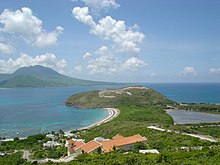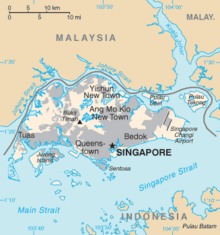Small state



Small state is a generic term for a small country, that has limited land, population, or resources. The term "small state" is similar to the term microstate or ministate, a sovereign state having a very small population or land area, usually both. However, the meanings of "state" and "very small" are not well-defined in international law.[2] Two important definitions for a small state are World Bank, which defines small state as those with less than 1.5 million people, which is about 40-50 countries, and the U.N. Forum on Small States which has higher threshold and includes about 100 countries, most of which are under 5 million people.
In practice small state is a usually inclusive to microstates;while microstates can be considered small states, not all small states are microstates. There is different criteria for defining small states.
Definitions of a Small State
Metrics for defining a small state look at aspects of country including area, population, size of the government, territory, and political situation.[3] One of the most common metrics to look at is population, which constraints other aspects, and countries with less than one million people is one common benchmark. However some institutions have used different standards, such as 1.5 million or higher, and especially if the states define themselves and want to be defined that way.[3] Two important listings of small states are the World Bank and the Forum on Small states, which includes about 50 and over 100 nations respectively.
Two thirds of U.N. members can be considered small states by some definitions, while World Bank made a list which is about 50 countries globally.[4] World Bank uses a threshold of 1.5 million population or less to describe a small state, which is about 40 nations, and there is another dozen close to 1.5 million but have similar issues as the other small states.[5]
World Bank lists the following countries as small states using their definition:[4]
- Antigua and Barbuda, Bahamas, Bahrain, Barbados, Belize, Bhutan, Botswana, Brunei, Cape Verde, Comoros, Cyprus, Djibouti, Dominica, Equatorial Guinea, Estonia, Fiji, Gabon, Gambia, Grenada, Guinea-Bissau, Guyana, Iceland, Jamaica, Kiribati, Lesotho, Maldives, Malta, Marshall Islands, Mauritius, Micronesia, Montenegro, Namibia, Nauru, Palau, Qatar, Saint Kitts and Nevis, Saint Lucia, Saint Vincent & the Grenadines, Samoa, San Marino, Sao Tome and Principe, Seychelles, Solomon Islands, Suriname, Swaziland, Timor-Leste, Tonga, Trinidad and Tobago, Tuvalu, and Vanuatu.
If a threshold of 1.5 million people was chosen, at one time this included about 30 countries.[4]
The point at which a small state becomes a microstate, has been defined in research as being as low as 100 thousand people but up to 1.5 million, though one million is most common.[3]
Researcher Elmer Plischke defined microstates as UN member states that a population of less than 100 000 people, or alternatively up to 300 thousand people. Whereas Dag Anckar used a limit of one million people, which multiple researches have chosen since the 1970s as the threshold for being a microstate, which includes the following scholars according to Archie Simpson, in On the Identification and Definition of Microstates: "Gunter (1977), Harden (1985), Richards (1990), Warrington (1994), Christopher (2002), and Simpson (2021).[6] The definition of a small states has been the subject or research, and precise defintions have been elusive.[7] One research paper in 2008, The elusive definition of the small state. states that the reason there is not a consensus definition of small states, is because different criteria have been used to define them, however, they suggest that this flexibility in definition is not a problem and is actually beneficial.[8]
The Commonwealth Secretariat defines 42 countries in the world to be small states, and further notes of these 33 of them are part of the Commonwealth of Nations. The Secretariat was founded in the 1980s to advocate for small states, noting their increased vulnerability.[9]
According to Forbes, the ten smallest countries in the world by area are Vatican City, Monaco, Nauru, Tuvalu, San Marino, Liechtenstein, Marshall Islands, Saint Kitts and Nevis, Maldives, and Malta, which range from .44 to 316 km2[10]
As member of Forum of Small States

One noted small states organization, is the UN group Forum of Small States, which as of the 2020s included over 100 nations.[11] This group does not have a precise definition but most are under 5 million people.[12]
Within the United States
Small state can also be used when talking about the states that compose the United States, which is one country with internal political divisions called states but are not independent.[13]
See also
- Forum of Small States
- Games of the Small States of Europe
- Libertarian conservatism#Small government conservatism
- Microstate
- Small power
- Alliance of Small Island States
- Small Island Developing States
References
- ^ [1]
- ^ Warrington, E. (1994). "Lilliputs Revisited". Asian Journal of Public Administration, 16(1).
- ^ a b c "On the Identification and Definition of Microstates | Columbia | Journal of International Affairs".
- ^ a b c "Diplomacy of small states". Archived from the original on 2022-02-27. Retrieved 2024-08-30.
- ^ "Overview". World Bank. Archived from the original on 2024-08-31. Retrieved 2024-08-31.
- ^ On the Identification and Definition of Microstates By Archie Simpson vol. 74, no. 2, "Microstates and Small Island States in International Affairs" (Spring/Summer 2022)
- ^ [https://www.researchgate.net/publication/233489400_The_elusive_definition_of_the_small_state The elusive definition of the small state January 2009International Politics 46(1):65-83 46(1):65-83 DOI:10.1057/ip.2008.37]
- ^ Maass, M. The elusive definition of the small state. Int Polit 46, 65–83 (2009). https://doi.org/10.1057/ip.2008.37
- ^ [2]
- ^ in area.Forbes Top 10 smallest countries in the world : Aug 26, 2024
- ^ "Members of the Forum of Small States (FOSS)" (PDF). "Ministry of Public Administration, Republic of Trinidad and Tobago". May 2022. Archived (PDF) from the original on 2024-03-28. Retrieved 2024-08-30., accessed= 28 Mar 2024
- ^ [3]
- ^ "What is the smallest state in the US? These are the 10 smallest states across America. Portrait of Mythili Devarakonda Mythili Devarakonda USA TODAY". Archived from the original on 2024-09-01. Retrieved 2024-08-30.











